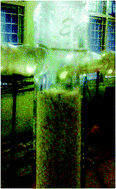Continuous flow reactive distillation process for biodiesel production using waste egg shells as heterogeneous catalysts
Abstract
A laboratory scale continuous flow jacketed reactive distillation (RD) unit was developed to evaluate the performance of calcium oxide (CaO) derived from egg shells as a heterogeneous catalyst for transesterification of waste frying oil. The effects of reactant flow rate, methanol to oil ratio and catalyst bed height on methyl ester conversion were investigated. All the experimental investigations were carried out at atmospheric pressure and the reboiler temperature was maintained at 65 °C throughout the process. The results indicated that the system reached the steady state at 7 h. Egg shell based CaO showed high catalytic activity in a continuous flow jacketed reactive distillation system and a maximum methyl ester conversion of 93.48% was obtained at a reactant flow rate of 0.2 mL min−1, methanol–oil ratio of 4 : 1 and catalyst bed height of 150 mm.


 Please wait while we load your content...
Please wait while we load your content...